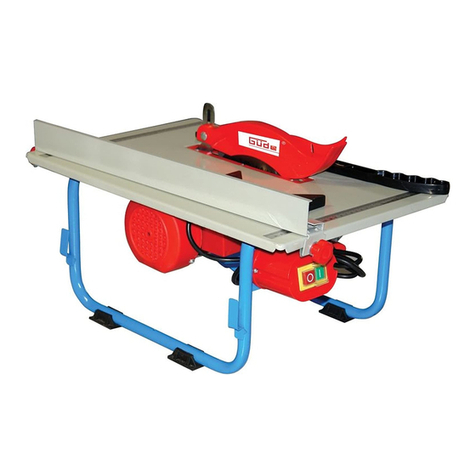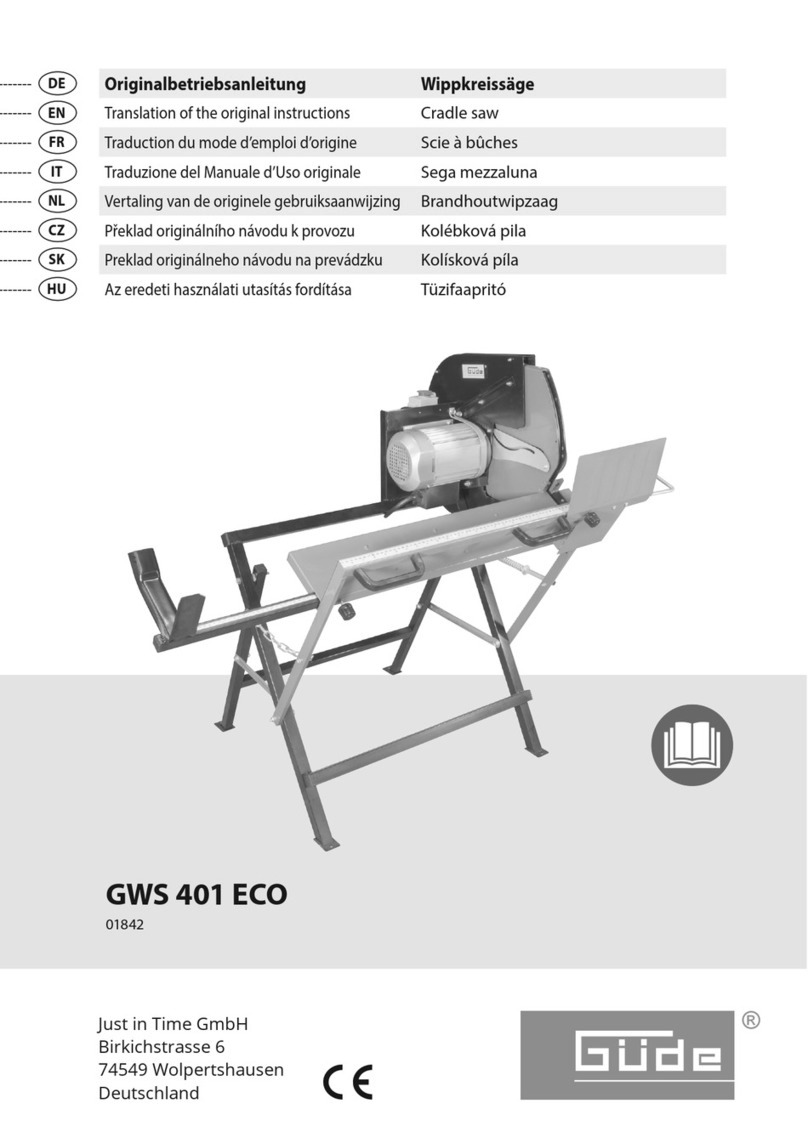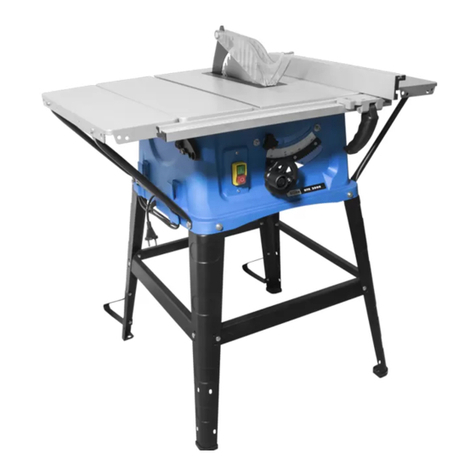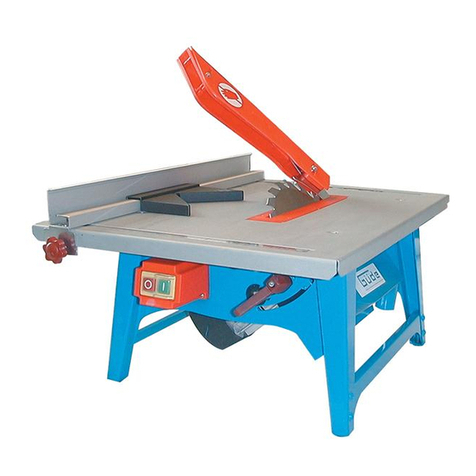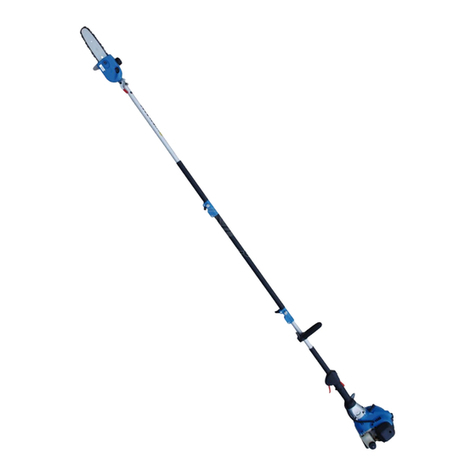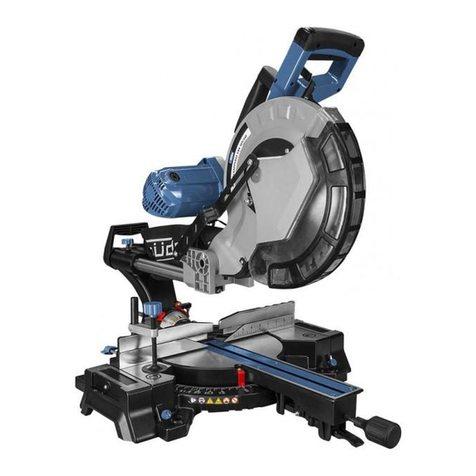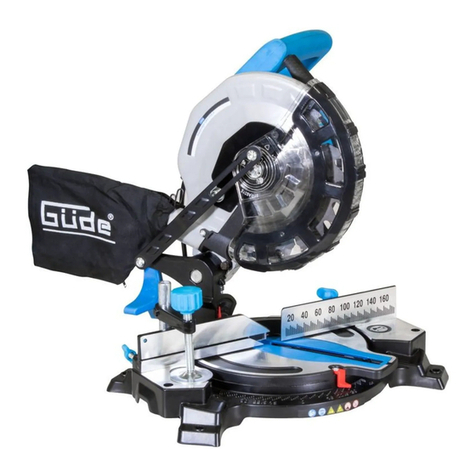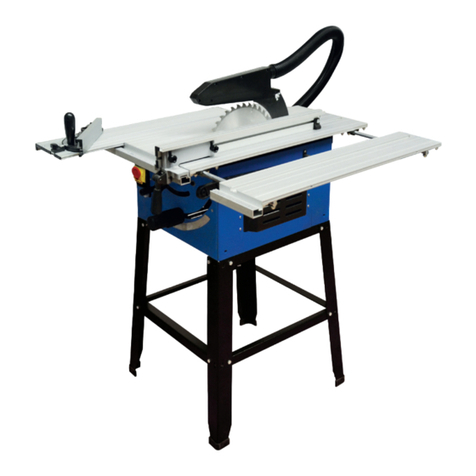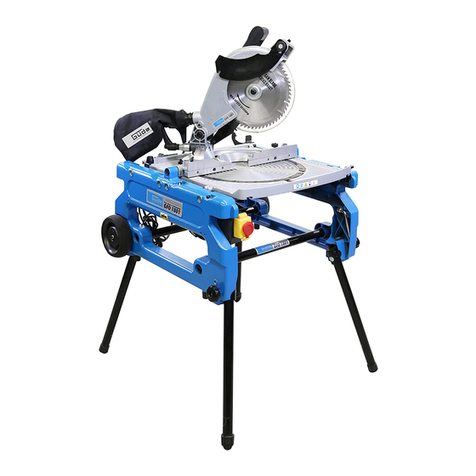
Before each use:
•Check the saw. If a part is missing, bent or
unserviceable for another reason, if there is a defect on
electrical equipment, switch the saw off and unplug it.
Prior to the following use, replace all the missing,
damaged or defective parts.
•Plan your job to have your eyes, hands, face and ears
protected at any time.
•Wear safety goggles meeting the requirements of DIN
58214. While the machine is in use, various particles
could get in your eyes and cause a permanent visual
impairment. You may buy the safety goggles at the place
where you bought the trimming saw. Using goggles not
in conformity with DIN 58214 may result in a serious
injury in result of a crack of the protection glass.
•When working on a dusty job, wear a dust-proof mask in
addition to the goggles.
•To prevent blocking of the saw disc in the kerfs or
throwing the cut material off:
•Select a saw disc matched to the specific job. Use this
trimming saw for wood and similar materials or soft
metals, such as aluminium.
•The arrow on the saw disc showing the rotation direction
should coincide with the arrow on the saw. The saw disc
teeth should direct downwards on the front of machine
•Make sure that the saw disc is sharp, undamaged and
properly set up. With the machine unplugged, push the
saw head downwards. Turn the saw disc with your hand
a check whether the movement is free. Turn the saw
head to the position at an angle of 45° and repeat the
check. If the disc drags at a place, the head should be
reset as described in Article 6 „Preparation Steps “
•Keep the saw disc and the saw disc flanges faces clean.
•Keep the saw disc and the saw disc flanges faces clean.
•The saw disc flanges should be fitted with the work
shoulder inwards (in the direction of the saw disc)
•The work shoulder side of the flange should tightly fit on
the saw disc flange.
•The flange screw should be fastened manually using a
socket spanner 13 mm.
•Make sure that all the attachment devices and locks are
tight and no component is allowed too much of free
travel.
•Never cut with free hand:
•Press the cut material down to the table and to the
stop all the time so that any swinging and turning is
prevented. No sawdust should collect under the cut
piece.
•Take steps to prevent any move of the piece after it is
cut through (e.g. if it does not touch the support with
its all surface
•For cutting pieces not abutting the plate with their all
surface, use supports, feeding aids or another
machine.
•Make sure that chips will fall away along the side of the
saw disc. If on the contrary, the chips could get stuck in
the disc and it would throw them off.
•Never cut several pieces at a time.
•Take special care when cutting large or very small
pieces or pieces difficult to handle.
•Use auxiliary supports (table, holders) for long
pieces that tend to fall down from the table when
unsupported.
•Never use this saw to cut pieces so small that they
cannot be safely held with hand if you put your
index finger on the stop outer edge.
•When cutting pieces of various profile, work so that
the material cannot slip and get jammed in the disc.
The pieces of various profiles should either attach
with all their surface areas or it is necessary to hold
them with a device that will prevent waggling,
turning or slipping during the course of cutting. .
•Round pieces, such as bars or tubes should be
held firmly otherwise, they would spin and there is a
risk of the disc getting stuck. Always clam round
pieces in a proper device.
•No nails or foreign matters should be left in the cut
pieces.
•The viewers should be kept at a safe distance from the
work area and the area behind the saw, where the
sawdust and chips go.
•Never switch the trimming saw before removing all the
things except for the piece to be cut and clamping
devices from the table.
•To prevent hearing deterioration, always wear ear
protectors when working for a longer time.
•To prevent being retracted in the disc,
1. Do not wear gloves
2. Put off any jewellery and wide garments.
3. If your hair is long, wear a hairnet.
4. Roll up the long sleeves above your elbows.
•Unplug the machine prior to any adjusting the end stop
or the saw head, replacement of the disc or accessories
and any other kind of maintenance in order to prevent
any accidents in result of unintentional switching on.
•Do not touch the metal pins of the plug when plugging in
to get protected from the electrical shock.
•Do not use the cable for pulling out the plug from the
socket.
Protect the cable against the high temperature, oil and
sharp edges.
•Never apply detergents or lubricants on this disc, which
still turning.
•To prevent fire, never operate the trimming saw close to
inflammable liquids, vapours or gases
•Avoid any accidents possibly resulting from the use of
improper accessories. Only recommended saw discs
should be used.
While the saw is running:
•Before the first cut, have the saw running idle for a while.
If you hear unusual sounds or feel strong vibrations,
switch the saw off, unplug and find out the cause. Do not
switch the saw on again before you find and remove the
cause.
•The cut off part should not be restricted in any way. Do
not touch it, do not hold it, do not clamp it and do not
place the end stop against it either. The cut off piece
should be able to move freely along the saw side. If you
prevent the motion in any way, it could get stuck and
thrown away with the rotating disc.
•Avoid any clumsy position of hands when your hands
could slip down or get stuck with the saw disc.
•Pay attention to the disc reaching full speed before
cutting.
•Switch the saw head at a speed so as to avoid any
motor overloading and blocking the disc.
•Before removing any jammed material switch the
machine off, let the disc stop and unplug the machine.
•With the cutting finished, hold the saw head pressed
down, release the switch and wait until the disc stops. It
is only then that you can move your hands.
Emergency Action
Apply the first aid adequate to the injury and get qualified
medical assistance as quickly as possible. Protect the injured
person from more accidents and calm him/her down.
For the sake of eventual accident, in accordance with DIN
13164, a workplace has to be fitted with a first-aid kit. It is
essential to replace any used material in the first-aid kit
immediately after it has been used. If you seek help, state
the following pieces of information:
1. Accident site
2. Accident type
3. Number of injured persons
4. Injury type(s)
